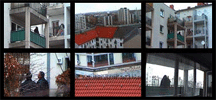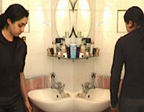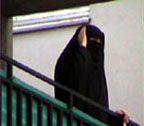January 06, 2006
Shahram Entekhabi

How to Perform Prayers
Fresh Azan (Quicktime), part of the installation "How to Perform Prayers," Videostills 3:04 min, colour/sound DVD/VHS – 2002/2003 (left)
The installation How to Perform Prayers--by Shahram Entekhabi--is composed of three videos, which show staged productions of existing religious rituals of the Islamic faith that differ by virtue of manipulations on the actual performing of these religious rites. The rituals presented here address the practicing of daily prayers, which Muslims are obliged to perform several times a day. Not only are these rituals compulsory for the entire Muslim world, they have remained unchanged for centuries. Through the use of disturbances, the work How to Perform Prayers pivots on the attempt to upset the collected rules of the religious canon and, in doing so, to also give weight, on a social level, to the idea of a rigidly-structured set of regulations being subject to change. All of the figures presented in the videos are women. In view of the Muslim theme this offers a new image since, in all hierarchically-structured world religions, women are discriminated against and dominated by a male-oriented image of the world – which, in itself, often encourages the Western world’s main criticism of the Islamic faith.

The video Wudu is based on a documentation of the cleansing ritual preceding prayer, enacted by a young woman in a household bathroom. The recorded material is doubled and assembled side by side in a way that divides the video image in two halves, thus showing two women. While on the image’s right side, the sequence of the cleansing ritual (three times the cleansing of the right then left hand, the elbows, the arms, the ears, the nostrils, the feet etc.) is faithfully captured, parallel to this, on the image’s left side, the entire sequence transpires in the reverse.

Azan is the Muslim call to prayer, cried several times a day by the muezzin of the minaret, beckoning believers to prayer in the mosque. The Azan is also used by devout Muslims when celebrating birth, in which case the call is whispered – as a rule, through a mullah – three times into the right and left ear. From that moment on, the newborn child belongs to the religious community. In the work Fresh Azan, a woman shrouded in a tschador appears on the balcony of a multistory apartment building, and sings a German-language version of the Azan. While her cries echo over the rooftops of the surrounding houses, catching the attention of passers-by, her call to prayer is accompanied by a male voice that whispers the Azan in Arabic.
Salath is actually the principal prayer of the Muslim world. It praises not only the glory of Allah, but also the absolute faith of believers and their allegiance to religious rules. Heard in the video is the voice of an old man of Iranian origin, the father of the one praying, reciting the prayer to his daughter. In the picture frame, one sees the young woman wearing the tschador kneeling on the prayer rug. She makes a great effort to repeat the Arabic words so foreign to her, and tries to assume the correct position with her body. Occasionally she interrupts the prayer and asks her father, in German now, to speak slower – or to repeat the words she finds hardest to remember. The woman’s actions oscillate between her allegiance to religious rules through sheer imitation and her rebelling against preordained rules of conduct, and the somewhat respectful tone used with her father belies her stifled laughter over the absurdity of the situation.

The video installation is supplemented by a Flash-generated animation entitled The Right Way To Pray, which, with explanations, leads through various instructional chapters on the underlying, prayer logic of the Islamic faith. Using the most advanced technologies, and a modern design, the viewer (at first an Internet user) is offered a comic-book-style and deliberately humorous, learning film. In combination with the videos, Sharahm Entekhabi once again interrupts, with this “ready made,” the rigid way of seeing, the so-called “western-oriented” gaze, directed Islamic culture. These works offer an unaccustomed and alternating glimpse at both the practice of daily prayers and the Muslim reality, but without falling prey to obsessive explanations. The artist playfully creates “counter images” which deliberately avoid exploring the exotic element in cultural differences; instead, these differences are questioned and presented here as unstable constructions.
Antje Weitzel, Berlin based curator
Posted by jo at January 6, 2006 09:43 AM
